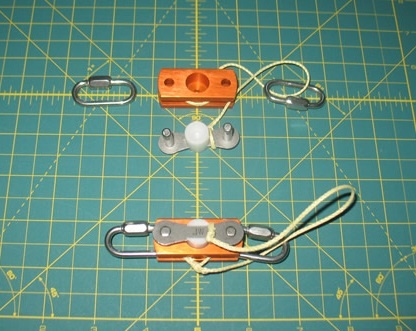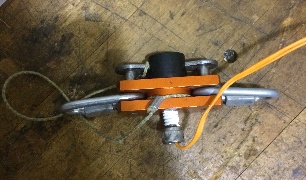Overview
The Tender descenders are used by the team for achieving a single separation dual deploy architecture.
Student Modifications
The Tender Descender currently used by Rocket Team has a hole drilled and tapped for a 1/4-20 bolt to screw in where the E-match is normally located. Our 1/4-20 bolts have holes drilled in them with E-match glued in–we call these "FireBolts." This allows us to screw our E-matches and secure them with Teflon tape.
Setup and Operation Checklist
Materials Needed:
- Tender Descender
- Two Quicklinks (make sure they fit in the Tender Descender)
- Black Powder
- Safety Supplies
- Scale, weighing tray, popsicle stick
- Teflon Tape
- Scissors
- FireBolt (1 for each firing!)
- Isopropanol
- Wiping Rag
Procedure:
- If needed, clean the Tender Descender with isopropanol and the rag. This needs to be done after each firing to remove the spent black powder residue.
- Put the Tender Descender string through one of the Quicklinks so it stays attached to our stuff after firing
- Ensure Quicklinks are tightened - it will be hard to turn the nut after they're integrated.
- Put the two Quicklinks (one of which now has the string through it) into the Tender Descender
- Put the bridge piece into the Tender Descender, unifying all of the components that have been used so far.
- Using a funnel, pour the pre-measured black powder charge into the small hole in the base of the Tender Descender. Pour slowly to avoid the funnel clogging.
- Wrap ~5 turns of Teflon Tape around the FireBolt. Generally go a little light rather than a little heavy. If too much tape is on, the FireBolt may not be able to drive far enough into the body.
- Screw the FireBolt into the Tender Descender, finger-tight. You definitely don't want more than ~4 threads of screw to be exposed.
- Attach Tender Descender to rest of system. Unscrew the system's Quicklinks, not the Tender Descender's, because again, it's hard to undo the TD's Quicklinks.
- When connecting the E-match to the firing system, ensure that the wires are well-gapped to avoid shorts.
Testing Campaign
Team Members are in the process of conducting tests to ensure that we understand proper Tender Descender operation and to verify our student modifications.
Test Session 1
The first phase of testing was performed September 30, 2017. This was done in the blast chamber in the basement of Building 37. ~8 people showed up to help. Our goal was to simply test whether we could make a Tender Descender "pop". We measured out 0.2 grams of black powder and set up the wiring using the long spool of wire which is often used for ground tests. We found that we were unable to trigger the E-match. We switched to using a short (~25 feet) extension cord (meant for 120 VAC) as our trigger wire. This allowed the E-match to fire. For future tests, we need to either use short wires, or use more-capable batteries. A LiPo battery would need to be completely charged for us to be confident in its ability to trigger the E-match through the long wire.
Once we swapped the wiring, we were able to activate the Tender Descender. We had four FireBolts made beforehand, and had just consumed one. We decided to replicate our first test with 0.2 grams of black powder. The best scale we had was 0.1 grams of precision, which we found was not really sufficient to measure things out accurately. We tried lowering the charge to 0.1 grams, but it seemed like it was just as volumetrically full inside the "cup" of the Tender Descender, and upon triggering seemed like it may have even been more energetic than the 0.2 gram tests. For the final test, we decided to forgo the scale. We used a popsicle stick to pull one "scoop" out of the canister of black powder, to see if this minimal amount would be enough to fire the separation. We found that it was indeed successful. This indicates to us that even a small charge can activate the Tender Descender, and that our larger charges will not be "borderline" in ability to fire.
Test Session 2
The second day of testing was October 8, 2017. This was again done in the blast chamber. Maddie J, Joey, Jakob, and Valeria showed up to do these tests. This time, we tested the Tender Descenders under load. To accomplish this, a length of paracord was looped around the metal brackets on the roof of the blast chamber. A quick link was attached to this. The Tender Descender was then attached to the quick link, and then two of the Rocket Team Standard Sandbags (each allegedly 25 pounds) were hooked to the bottom. The Tender Descender was approximately at eye level.
Upon setting up for the tests, we found that our scale for the black powder was not being accurate. The reading was changing and displaying impossible values. We therefore made the decision to measure volumetrically. This is the vial, with markings for the amounts of powder used:
Our first test was done with powder up to A, which produced an explosion that seemed much louder than it should have been. Therefore all subsequent tests were done with the amount labeled B. The mark at A was at the "0.5" marking pre-made on the plastic, which is presumably milliliters. When a better scale is obtained, we ought to re-check what these volumes are and back-measure the mass of powder.
After test 1, we had mild difficulty finding the Tender Descender in the blast chamber (since we had not thought to attach it to either side of the suspended system). This taught us to add "pass the string through one quick link to keep the expended Tender Descender retained". Test 2, with B amount of powder, seemed to work perfectly. We wanted to try again to verify a second time, and had a surprising result.
For Test 3, we again used volume B of black powder. We then hooked up the system, and attempted to fire the FireBolt. Nothing happened. After waiting the standard 1 minute after a failed pyrotechnic, we entered the room and found that one of the E-match's wires was broken, and that both were discolored. We deduced that the wires had been crossed (shorted), and therefore the power had not flown to the E-match head. Upon reviewing the footage, we indeed saw a bright light where the wires connected, confirming this hypothesis. After un-shorting the wires and reattaching everything, we had a successful firing, at which point we decided sufficient data had been gathered.

